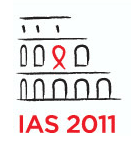 Though there has been a significant increase in osteoporotic bone fracture rates in the years since combination antiretroviral (ARV) therapy became commonplace in countries like the United States, the drugs themselves do not appear to be chief culprits, according to new Veterans Administration data presented Monday, July 18, at the 6th IAS Conference on HIV Pathogenesis, Treatment and Prevention in Rome.
Though there has been a significant increase in osteoporotic bone fracture rates in the years since combination antiretroviral (ARV) therapy became commonplace in countries like the United States, the drugs themselves do not appear to be chief culprits, according to new Veterans Administration data presented Monday, July 18, at the 6th IAS Conference on HIV Pathogenesis, Treatment and Prevention in Rome.
While the study concludes that tenofovir (found in Viread, Truvada and Atripla), as well as Kaletra (lopinavir/ritonavir), were independently associated with an increased risk of osteoporotic fractures among those who started HIV treatment since 1996, the researchers point out that traditional factors for fractures—race, aging, smoking and diabetes—are much greater contributors to the risk.
As their name implies, osteoporotic fractures (OFs) involve bone that are more prone to break or fracture because they lack healthy bone mineral density levels. Areas most commonly affected include the hip, wrist and spine. OFs are sometimes referred to as fragility fractures, and they often result from a fall at standing height. And because fragility fractures can significantly reduce mobility, they can lead to other health complications and even reduce survival rates.
As Roger Bedimo, MD, of the University of Texas Southwestern Medical Center in Dallas explained in his introduction, OFs are becoming increasingly common in people living with HIV and taking ARV therapy, compared with those who are HIV negative. Though at least two studies have suggested that one commonly used ARV, tenofovir, reduces bone mineral density (BMD) more than similar HIV drugs, the risk of fractures and its association with tenofovir treatment have never been explored.
To shed light on a possible link between the two, Bedimo and his colleagues conducted an analysis of more than 56,000 people living with HIV and receiving care from the Veterans Administration between 1988 and 2009. The researchers also looked specifically at more than 33,000 veterans who starting receiving HIV care from 1996 onward—the era of combination ARV treatment.
A total of 951 OFs were documented in the whole study population; 572 OFs were noted in those who entered care from 1996 to 2009.
About 1.61 fractures per 100 person-years were documented from 1998 to 1995, whereas the rate nearly quadrupled from 1996 to 2009.
When Bedimo’s group looked at the factors associated with OFs, white race, older age, smoking, lower body mass index and hepatitis C virus (HCV) coinfection were all considered to be statistically significant risk factors. Being on ARV therapy also was found to be a factor—there was a 5 percent increase in the risk—but when the data were adjusted to more traditional risk factors such as those listed previously, ARV treatment was not found to be independently associated with a greater risk of fragility fractures.
In looking at the entire cohort, researchers found that tenofovir and a Norvir-boosted treatment of protease inhibitors increased the risk of OFs by 8 percent and 6 percent, respectively, compared with other ARVs. However, when the data were adjusted for other risk factors, the increased risks were not statistically significant.
When Bedimo’s group looked only at those who entered HIV care and started treatment between 1996 and 2009, tenofovir was associated with an increased OF risk of 12 percent, a finding that was statistically significant after adjusting the data for other risk factors.
Norvir-boosted protease inhibitors increased the risk of OFs 8 percent. Kaletra stood out as the most likely contributor, after Bedimo’s group found that boosted Reyataz (atazanavir) and Crixivan (indinavir) were not associated with an increased risk.
While they documented links between tenofovir, Kaletra and OF risk, Bedimo and his colleagues reiterated that traditional risk factors were much greater in their associations with fragility fractures. White race, increasing age, tobacco use, diabetes, low body mass indexes (below 20) and HCV coinfection were each associated with a 10 percent or greater increase in the risk of a fragility fracture—and these factors are likely the greatest causes for concern regarding bone fractures in the modern-day HIV treatment era.






1 Comment
1 Comment